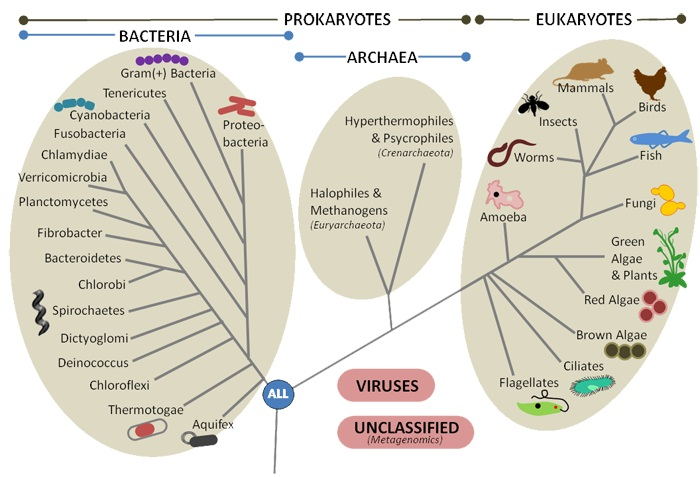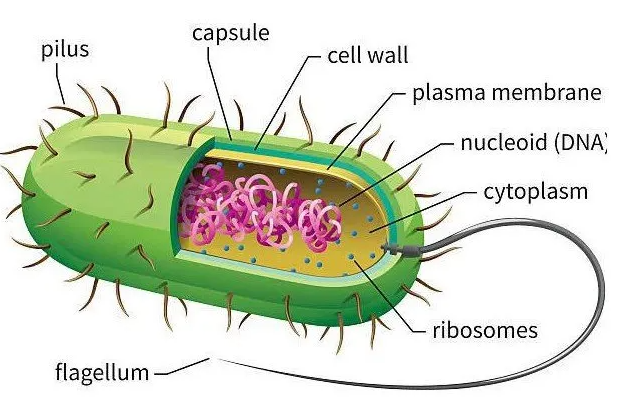The oldest forms of life on record date back to 3.8 billion years ago and were prokaryotic in nature (cells without a nucleus). Eukaryotic species emerged around 1.8 billion years ago. The current number of living species on Earth is likely in the tens of millions, with the majority being prokaryotic organisms.
Prokaryotic organisms are unicellular and lack a nucleus to separate genetic material from the rest of the cell. It was thought that the prokaryotic world was made up of bacteria, but RNA sequence analysis carried out in the 1980s showed significant genetic differences between two groups of prokaryotes; bacteria and archaea. Although they look similar externally, the biochemical differences are so significant that they necessitate the classification of living beings into three domains: bacteria, archaea, and eukaryotes.
All multicellular living beings (animals, plants, fungi, etc.) are made up of eukaryotic cells, however, the biomass formed by prokaryotes is 10 times greater. Eukaryotic cells are found in soil, water, air, live in the digestive tracts of animals, on the skin, and can even be found several kilometers deep.

Las Bacterias Bacteria exhibit a wide biochemical diversity, adapted to the available energy source. There are bacteria capable of extracting energy from inorganic molecules, others have photosynthetic abilities and use light energy to transform carbon dioxide into organic molecules.
Bacteria exhibit a wide biochemical diversity, adapted to the available energy source. There are bacteria capable of extracting energy from inorganic molecules, others have photosynthetic abilities and use light energy to transform carbon dioxide into organic molecules.
Bacteria are fundamental in the carbon, nitrogen, and sulfur cycles. They participate in the decomposition of dead organisms, releasing nutrients that can subsequently be used by living organisms.
As an example, we can mention the bacterium Rhizobium, a gram-negative bacterium capable of fixing atmospheric nitrogen and transforming it into ammonia. They live in the roots of leguminous plants providing them with the nitrogen they need, in return the plant provides shelter, undoubtedly a fascinating example of symbiosis.
Although some species of bacteria are very harmful to humans, causing serious diseases (cholera, tuberculosis, tetanus) others have important industrial applications, such as Lactobacillus bulgaricus and Spreptococcus thermophillus responsible for lactic fermentation processes that allow the production of yogurt and cheese.
Another species of bacteria to which humanity will always owe a debt are the actinomycetes, from which numerous antibiotics have been isolated.
Bacteria have also been very important in biochemical research, especially Escherichia coli, which has allowed most of the basic biochemical processes to be elucidated.
Archaea
Archaea are prokaryotic cells, but biochemically more similar to eukaryotes than to bacteria in many respects, for example, protein synthesis is more similar to that of eukaryotic cells. Archaea are capable of adapting and thriving in any habitat. Special mention goes to extremophilic archaea, species of archaea capable of living in conditions of extreme temperature, pH, salinity, or pressure.
The study of extremophilic archaea has allowed the isolation of numerous extremozymes of great utility. For example, Taq polymerase used in PCR was isolated from Thermus aquaticus, or Pfu polymerase, isolated from the hyperthermophilic Pyrococcus furiosus.
Another application of archaea is the degradation of polluting materials, such as oil spills.
Eukaryotes Eukaryotes constitute the third domain of living beings, with the existence of a nuclear membrane that envelops and protects the genetic material being the most significant difference from prokaryotic cells. Let's look at more differences between eukaryotic and prokaryotic cells:
Eukaryotes constitute the third domain of living beings, with the existence of a nuclear membrane that envelops and protects the genetic material being the most significant difference from prokaryotic cells. Let's look at more differences between eukaryotic and prokaryotic cells:
- Eukaryotic animal cells have a diameter between 10 and 30 micrometers, while in prokaryotes it ranges between 1 and 3 micrometers, that is, eukaryotes are about 10 times larger.
- Eukaryotic cells are made up of organelles that perform specific tasks. The existence of these organelles allows concentrating in certain places of the cell the reactants that will participate in specific biochemical processes, which increases the efficiency of these processes.
- Only in eukaryotic organisms is there true multicellularity. It is not just about a set of cells joined together, there is cooperation and communication between them, in addition to the specialization that allows the existence of complex and perfectly ordered organisms.

